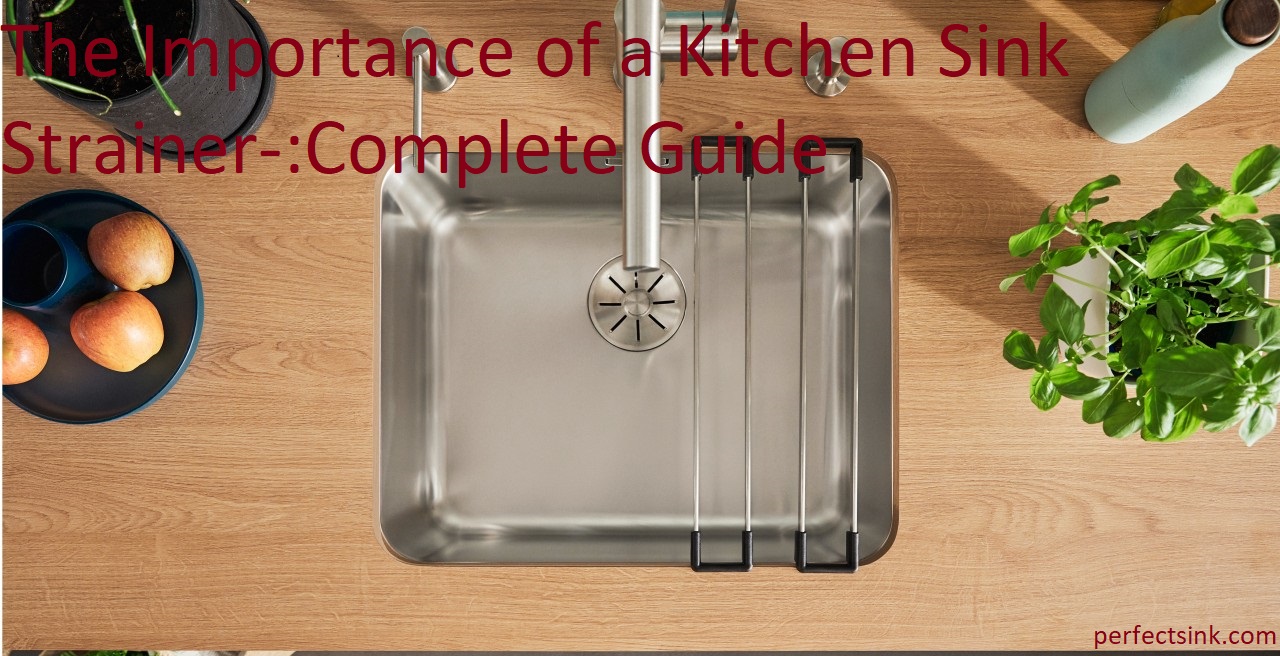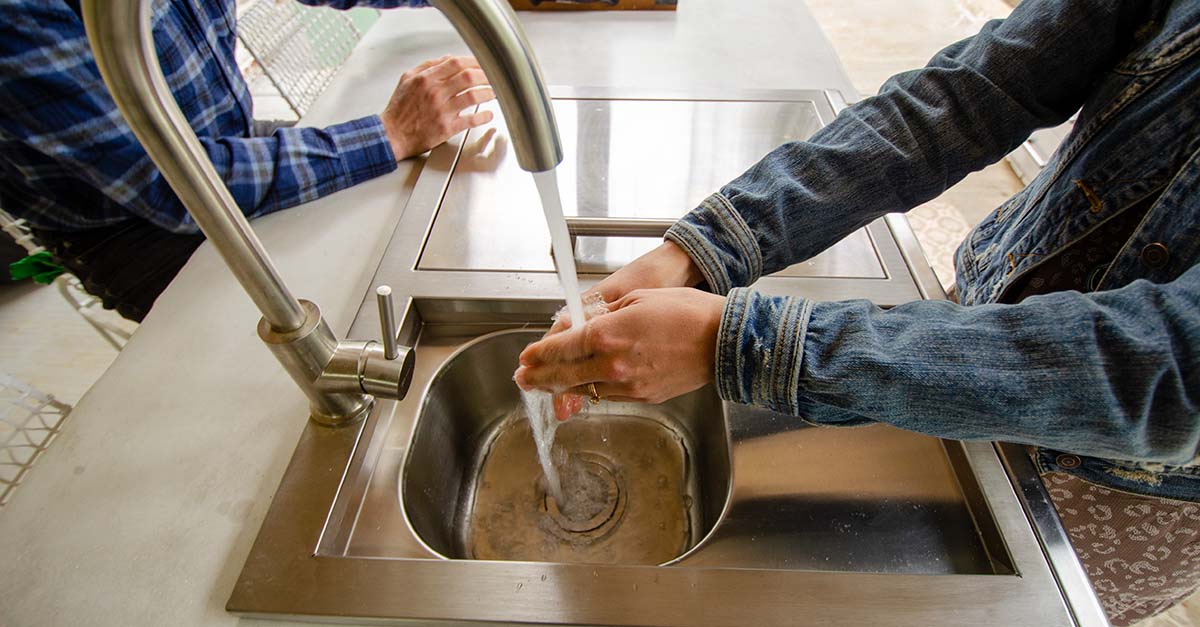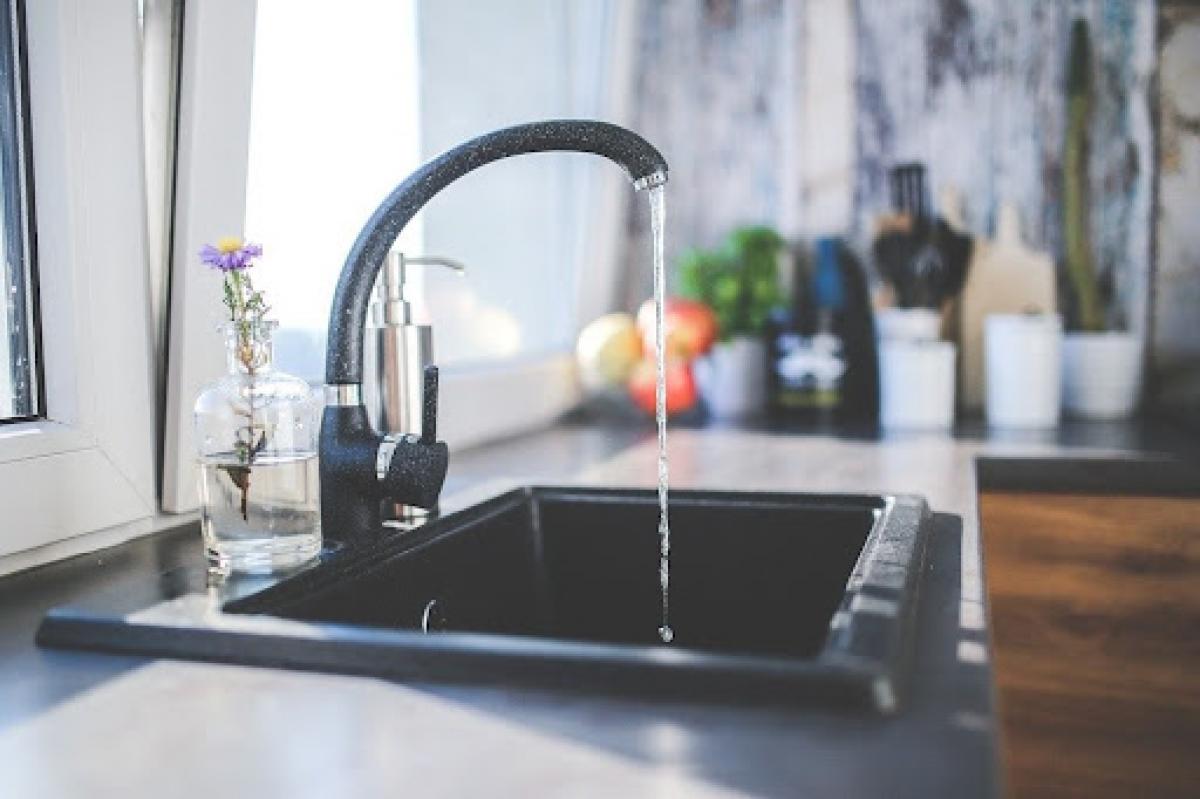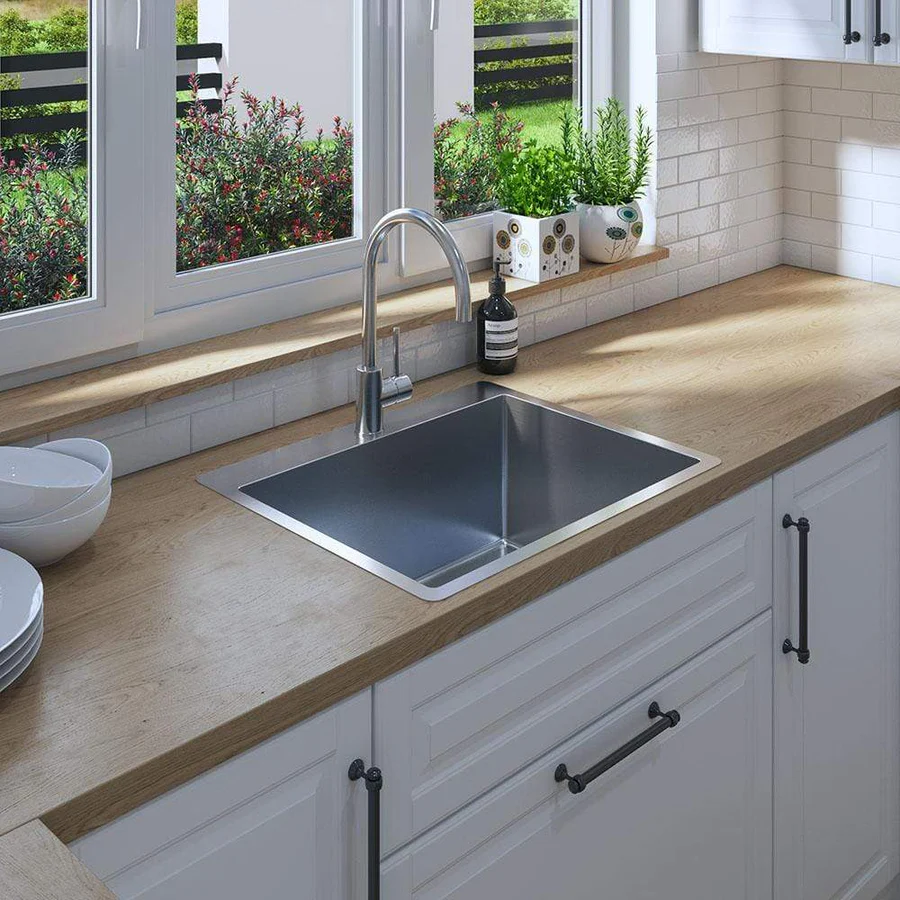Are you worried about the health of your kitchen sink? A kitchen sink strainer can help you avoid clogged pipes and keep your kitchen clean. You don’t need to get a professional installer—here’s everything you need to know about selecting and installing a kitchen sink strainer.
When it comes to home maintenance, having a kitchen sink strainer is an essential part of keeping your sink plumbing and drain working properly. Sink strainers capture food particles and other debris, preventing them from entering the drain pipes and causing clogs. They also serve another important function: they keep large items such as silverware and cooking utensils from going down the drain. Having a high-quality strainer in place is essential for any home.

Explanation of what a kitchen sink strainer is
A kitchen sink strainer is a device that is placed inside the sink drain opening to prevent debris and other objects from entering the drainage system. The strainer also prevents large items, such as cutlery and utensils, from being washed away with water running down the drain. Proper installation of a kitchen sink strainer is an important part of any kitchen renovation project or plumbing task.
Kitchen sink strainers come in a variety of materials, including metal mesh, plastic mesh, open slot designs and rubber gaskets. While metal mesh may be slightly stronger than its plastic counterpart, it can sometimes cause rusting of the steel components due to contact with water containing minerals or chemicals. Open slots are often positioned in circular patterns so that food pieces can fall through easily without causing clogging. Rubber gaskets provide an extra layer of protection against particles which are too large for metal mesh to trap.
The type of material that should be used depends heavily on where the strainer will be installed and what type of materials are often surrounding it such as grease, hair or dirt. It is always wise to consult with a professional plumber before selecting a strainer for your kitchen sink to ensure that it will last for many years without wearing down or becoming jammed with food particles over time. Kitchen sink strainers can be purchased from most home improvement stores or online retailers in both single and double models depending on personal preference.
Benefits of using a kitchen sink strainer
A kitchen sink strainer can provide a number of benefits to the homeowner. One benefit is that it helps keep food particles, grease and other debris from getting into your drain, which can accumulate and block the flow of water. It also helps to trap items such as earrings and other small items that may find their way down the drain by accident.
Additionally, using a kitchen sink strainer reduces the amount of maintenance required on your sink and plumbing system, as fewer build-ups means less frequent cleanings. Finally, having a kitchen sink strainer in place allows you to conduct regular inspections on your drainage system – catching potential problems before they require costly repairs or replacements.
Prevents food scraps and other debris from going down the drain

Having a kitchen sink strainer is essential in preventing food scraps, debris, dirt and other waste from passing through to the drains. This will help keep the entire plumbing system working efficiently and can extend the life of your sink. A kitchen sink strainer can help trap anything that accidentally gets into the drain, such as small pieces of garbage, scraps from vegetables and even hair from washing dishes by hand. This will help keep your drains clean and free from clogging or build-up that can cause major issues down the road.
A kitchen sink strainer also helps protect against anything larger than its holes – usually around 1/8” – being washed down the drain, including silverware, bottle caps and toy pieces. All these small items get caught on top of the strainer while still allowing water to pass through underneath. By catching anything larger than 1/8” in size before it goes down the drain pipe, you won’t have to worry about blockages or bigger clogs further down in your plumbing system.
The type of material used for a kitchen sink strainer is also important for keeping your sinks working correctly for years to come. Traditional strainers are made of stainless steel mesh with plastic frames; this construction requires regular maintenance if you want them to continue to perform well over time. There are other types of strainers made out of different materials like silicone or rubber that don’t need as much upkeep on a regular basis. It’s best to research which type suits your particular needs before making a final decision on what kind of strainer you want in your home.
Helps to avoid clogs and blockages in the pipes
Kitchen sink strainers are a simple yet effective tool for keeping objects from going down the drain and potentially causing blockages, which can result in costly repairs. Placing a sink strainer in your kitchen drain creates a barrier to catch large pieces of food, hair, and other items that could cause clogs. This helps to protect both the sink pipes and your plumbing system from damage, avoiding difficult-to-remove blockages and allowing water to flow freely. Additionally, many kitchen strainers are designed with removable bowls that allow you to easily remove debris before it accumulates too much and becomes stuck in your pipes.
Aside from the potential of preventing major plumbing problems, high-quality kitchen strainers also increase drainage efficiency in sinks by helping maximize water flow through the drain. By installing a strainer, you may be able to reduce long-term wear on your pipes and keep them functioning over time. Plus, because there are so many styles available on the market today — including ones made of metal mesh or stainless steel — you’ll also be able to complete any kitchen aesthetic style with ease.
Kitchen sink strainers are an easy way to help prevent clogs from developing in your drains and avoid more expensive repairs down the line. Investing in a quality strainer has multiple benefits for both function and design — keeping all those little daily items from building up inside your pipes will give you peace of mind while helping maintain an efficient functioning sink!
How to choose the right kitchen sink strainer
Kitchen sink drain strainers come in many shapes, sizes and materials to suit different needs. Before you purchase a strainer, consider what type of use it will receive and what will fit your kitchen’s look. Here are the important factors to consider when selecting a kitchen sink drain strainer:
Shapes and Sizes: Look for a strainer that fits the size of your drain opening. For example, over-the-sink colanders are available in different sizes with round or square drains that sit atop your sink basin. Single and double strainers can also be found with bowl-shaped or cone-shaped baskets, which typically accommodate larger items like potato peelings or large seeds without clogging the drain.
Materials: Choosing between stainless steel, enameled cast iron or plastic depends largely on personal preference because each material is designed to protect your sink basin from objects that may clog the plumbing and cause water damage. Enameled cast iron is the most traditional look; however, it can chip more easily than other materials so be sure to select one that has been designed for durability and a long life span. Plastic strainers are usually more affordable than their metal counterparts but may need replacing after a few years of wear and tear from heavy kitchen use. Stainless steel offers a combination of beauty and affordability; it looks good and is built to last for years with minimal maintenance needed.
Size and compatibility with your sink

Once you’ve identified the right strainers for your property, it is important to choose the correct size. The size of the strainer needs to fit in your sink— both in terms of height and width. An extra-large strainer is too big for a small sink, just as a smaller one won’t fit into an extra-large sink. Additionally, it is important to realize that kitchen sinks are available with standard and non-standard shapes and sizes so it’s best to measure yours before buying.
When purchasing a strainer, make sure that the diameter fits inside the opening of your sink— small strainers will not fit in wide sinks, large strainers will not fit in narrow ones. It also can be useful to research whether or not different manufacturers make compatible cases, plugs or hole covers that can work with your particular brand and style of sink drain if needed.
Make sure you also check out how long a strainer comes up from underneath the bottom of your sink— some models may require adjustment by trimming them down or having them custom made depending on how much room there is beneath the drain pipe. Lastly, some sinks have secondary drainage pits where a separate strainer can be used; ensure you know what type of pit is required for your product before making any changes or purchases.
Material
When it comes to picking the right kitchen sink strainer, the material is one of the most important factors to consider. It must be resilient enough to take a lot of abuse and wear in a tough kitchen environment. Certain materials offer corrosion resistance and durability that can endure small particles and pieces of food waste. Here are some popular materials available for kitchen sink strainers.
Stainless steel: This type of material offers great corrosion resistance when exposed to moisture in a humid environment like a kitchen sink, as well as durability against scratches and dents from pots and dishes.
Polypropylene: Usually used for lightweight applications, polypropylene is known for its chemical compatibility in hot and acidic liquids or for harsh environments where metals may corrode quickly.
Rubber: Be sure your rubber strainer can fit snugly into your sink drain; this element is essential to prevent leakage and maintain proper drainage over time. Also look for an option that fits securely around the entire circumference of the drain so it won’t move or slip out while in use.
Copper: Copper strainers are both decorative and functional; many homeowners choose copper because it resists rusting better than other metal materials, even after years of use in a wet environment.
Durability and longevity

When it comes to kitchen sink strainers, there is no one-size-fits-all. Strainers come in a wide variety of shapes, materials, and sizes to fit any sink. It’s important to select the correct type of strainer for your particular sink in order for it to function correctly—and last a long time.
Durability and longevity are of utmost importance when it comes to strainers. When purchasing a strainer, be sure that the material from which it is made of is long-lasting and high-quality. Common materials used in kitchen sink strainers include stainless steel, polypropylene plastic, copper, and bronze. Stainless steel offers the greatest longevity due to its corrosion resistance and strength. Corrosion resistance means that the metal will not rust over time no matter how much water goes through it or what kind of objects pass through its filter mesh. Strong materials also hold up better against higher levels of stress and pressure than weaker ones.
Additionally, look for features such as rubber stoppers or seals that keep smaller items from slipping through cracks or holes. These features will make the strainer last much longer than one without them.
Conclusion
In conclusion, a kitchen sink strainer is essential to prevent potentially damaging particles such as dirt, food, and hair from clogging your plumbing and potentially leading to costly home repairs.
Strainers come in many shapes and sizes to fit standard size sinks. Additionally, many feature a mesh material design that enables water to pass through while trapping any debris or particles.
Make sure you review your drainage option for size compatibility before purchasing the product for an optimal fit.
Finally, be sure to consult a local plumber or expert if you are unsure how to inspect and clean out the strainer when required.
FAQ’s
What are the benefits of a sink strainer?
A sink strainer helps to prevent food scraps, hair, and other debris from entering your drain pipes and causing blockages. It also makes it easier to clean your sink by trapping large debris on top of the strainer and preventing it from going down the drain.
Are kitchen sink strainers necessary?
While kitchen sink strainers are not essential, they are highly recommended. They can help prevent costly plumbing repairs caused by blockages in your drain pipes, and they make cleaning your sink much easier.
What is the importance of kitchen sink?
The kitchen sink is an important feature of any kitchen as it provides a place for washing dishes, preparing food, and cleaning up messes. It is also a key component of the plumbing system and must be properly maintained to prevent blockages and other issues.
How does kitchen sink strainer work?
A kitchen sink strainer fits into the drain hole of your sink and catches any large debris that might otherwise go down the drain. The strainer has small holes that allow water to pass through while trapping food scraps and other debris on top of the strainer.
What is the main purpose of a strainer?
The main purpose of a strainer is to remove solid particles from a liquid or gas. Strainers can be used in a variety of settings, including in the kitchen, for brewing coffee, in industrial processes, and in water treatment plants.
What is the function and uses of strainer?
The function of a strainer is to separate solid particles from a liquid or gas. Strainers can be used for a variety of purposes, such as removing food scraps from dishwater, filtering impurities from industrial chemicals, or purifying water.
Which sink strainer is best?
There are many types of sink strainers available, including mesh strainers, basket strainers, and disposable strainers. The best type of strainer for your sink will depend on your needs and preferences. Mesh strainers are often the most versatile and effective, while basket strainers are more durable and long-lasting.
What is the purpose of a sink trap?
A sink trap, also known as a P-trap, is a curved section of pipe that is installed beneath a sink. The purpose of a sink trap is to prevent sewer gases from entering your home by creating a water barrier that traps debris and odors.
Are strainers necessary?
Strainers are not always necessary, but they can be very helpful in preventing blockages and other issues. In some cases, such as when brewing coffee or cooking pasta, a strainer may be essential to achieve the desired outcome.
What to do if you don’t have a strainer?
If you don’t have a strainer, you can use a variety of household items to strain liquids and remove solid particles. For example, a clean piece of cheesecloth or a coffee filter can be used to strain broth or stock, while a colander or sieve can be used to strain pasta or vegetables.
See Also:
- Best kitchen sink strainer 2023
- Best utility sink 2023
- Best kitchen sink material 2023
- Best hair catcher for bathroom sink 2023
- Best granite kitchen sink 2023

